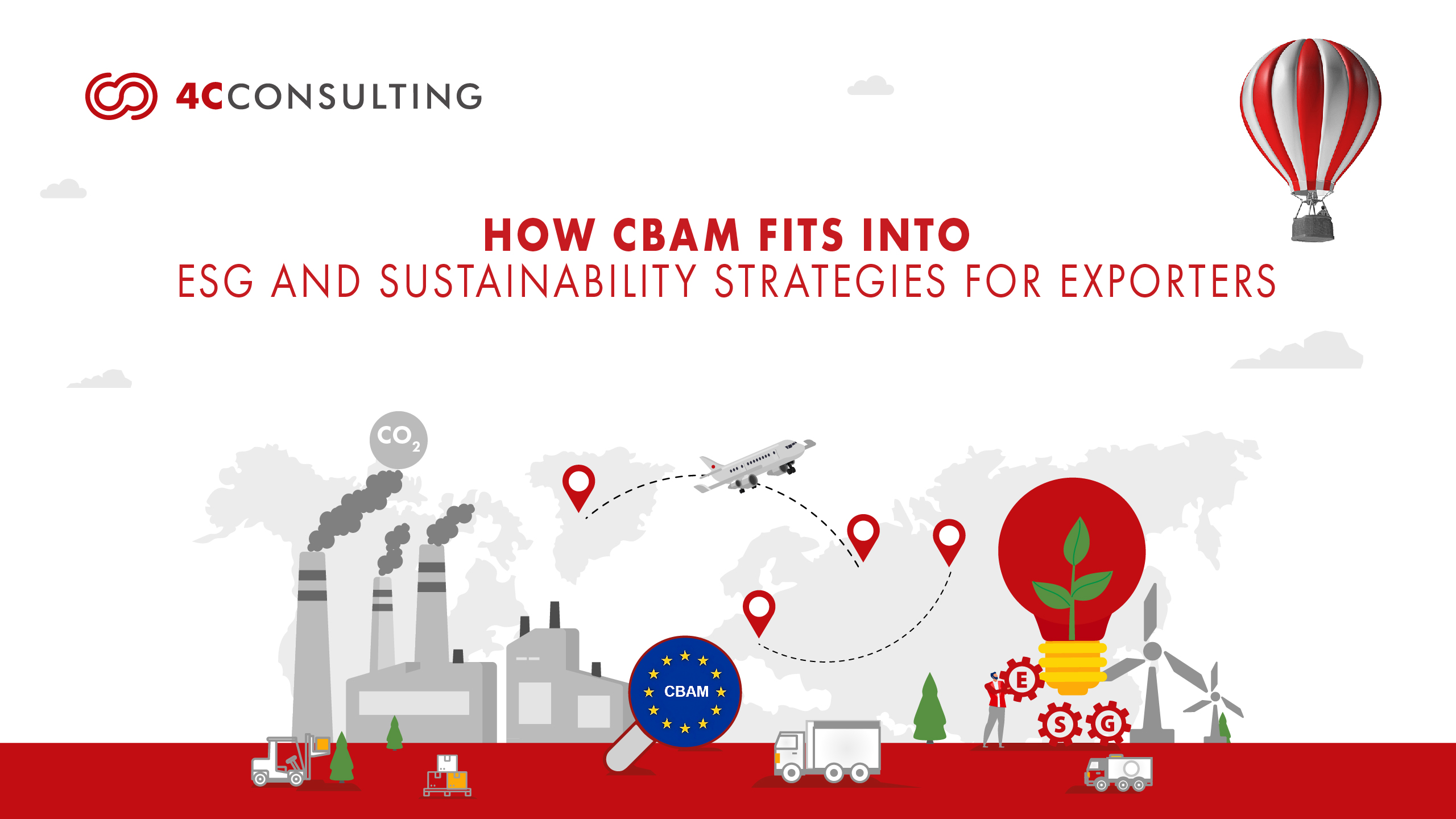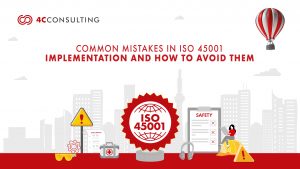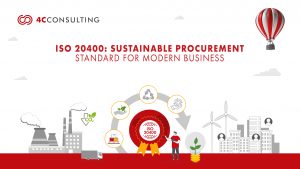HOW CBAM FITS INTO ESG AND SUSTAINABILITY STRATEGIES FOR EXPORTERS?
4th Oct, 2025Global trade is no longer defined only by cost, speed and quality. Carbon emissions have now become a decisive factor of competitiveness. At the centre of this shift is the European Union’s Carbon Border Adjustment Mechanism (CBAM), which makes verified carbon disclosure a binding requirement for entry into EU markets. For exporters in energy-intensive sectors such as steel, aluminium, cement, fertilizers, electricity and hydrogen this marks a fundamental change. Every product destined for the EU must carry accurate carbon data, verified through independent third-party assessments and aligned with CBAM regulations that can withstand audit scrutiny. Unlike voluntary ESG initiatives, CBAM is a compliance-driven system that links trade with climate accountability.
Exporters who act early will secure EU market continuity, build ESG credibility and improve efficiency. Those who delay risk higher costs, rejected consignments and reputational setbacks. This blog explores what CBAM is, how it connects with ESG strategies the practical steps exporters must take to remain compliant and competitive.
Companies that act early can improve ESG ratings, secure sustainability-linked financing and enhance operational efficiency through decarbonization. More importantly, proactive exporters position themselves as preferred partners for EU buyers, setting the stage for deeper alignment between CBAM compliance and long-term ESG strategies..
.
CBAM and ESG: Integrating Compliance with Sustainability Strategy
| Dimension | CBAM (Carbon Border Adjustment Mechanism) | ESG (Environmental, Social & Governance) | What It Means for Exporters |
|---|
| Nature | Legally binding EU trade regulation applying a carbon price to imports. | A corporate sustainability framework evaluating environmental, social and governance practices. | CBAM is mandatory for EU trade; ESG is increasingly expected by investors and buyers. |
| Scope of Coverage | Focused on product-level carbon emissions in high-emission sectors (steel, aluminium, cement, fertilizers, electricity, hydrogen). | Covers the entire organization, including environmental, labour, ethics and compliance practices. | Exporters in CBAM sectors must also show ESG maturity to stay competitive globally. |
| Primary Objective | Prevent carbon leakage and ensure imports face the same climate obligations as EU producers. | Demonstrate responsible and sustainable business practices across all functions. | CBAM ensures compliance for trade access; ESG builds trust and reputation beyond compliance. |
| Regulatory Status | Enforced by the European Commission under Regulation (EU) 2023/956. | Guided by frameworks such as GRI, CSRD, SASB and EcoVadis, often voluntary but moving toward mandatory. | Exporters must treat CBAM as law and ESG as a strategic requirement. |
| Verification | Requires independent third-party verification of emissions data per product shipment. | ESG disclosures increasingly require assurance or audit under CSRD and investor standards. | Both demand credible, auditable data—greenwashing is no longer tolerated. |
| Financial Impact | Direct costs via CBAM certificates and tariffs on carbon-intensive imports. | Indirect financial impact through access to capital, investor trust and procurement preferences. | Carbon now affects both customs duties and capital flows; exporters must treat it as a KPI. |
| Supply Chain Impact | Requires supplier-level emissions data for accurate carbon calculations. | Reviews ethical and sustainable sourcing, labour rights and supplier compliance across value chains. | Exporters need integrated supply chain reporting covering both carbon and social aspects. |
| Market Impact | Acts as a gatekeeper for EU trade access—without verified data, no market entry. | Acts as a decision factor for investors and global buyers in supplier selection. | Compliance becomes a competitive differentiator in both trade and procurement. |
| Future Direction | Will expand to more sectors by 2030 and may include Scope 3 emissions later. | Moving from voluntary to mandatory disclosures in EU and globally (e.g., CSRD, SEBI). | Early integration ensures exporters are future-ready against tightening regulations. |
.
.
Identify the Right Sustainability Platform to Strengthen Global Supply Chain Performance.
HOW CBAM STRENGTHENS ESG STRATEGY?
The EU’s Carbon Border Adjustment Mechanism (CBAM) is reshaping the way companies approach sustainability. More than just a trade regulation, it is a driver of ESG (Environmental, Social and Governance) maturity. By linking carbon costs to market access, CBAM forces exporters to align operations, supply chains and reporting frameworks with global sustainability expectations. Here are seven ways CBAM strengthens ESG strategy:
- Decarbonization Accountability: CBAM requires exporters of steel, cement, aluminium, fertilizers, electricity and hydrogen to report the carbon emissions in their products. This pushes companies to adopt cleaner technologies such as electric arc furnaces, low-clinker cement or renewable hydrogen. Such as Steel manufacturer investing in solar-powered furnaces not only reduces CBAM-related tariffs but also improves its ESG climate disclosures. By making emissions visible, CBAM directly enforces environmental accountability, strengthening the ESG.
- Supply Chain Transparency: CBAM compliance depends on accurate data across the supply chain. Exporters in chemicals and pharmaceuticals must verify the emissions of raw material suppliers, packaging partners and logistics providers. A pharma company may require its contract manufacturers to submit verified energy and emissions data through digital MRV (Monitoring, Reporting & Verification) systems. This process enhances traceability and transparency, aligning CBAM compliance with ESG governance standards. It ensures companies not only cut carbon but also uphold ethical, safe and responsible practices across the supply chain.
- Trade Competitiveness: CBAM transforms carbon efficiency into a market differentiator. Companies that embrace ESG frameworks gain an advantage by avoiding penalties, qualifying for low-carbon certifications and meeting buyer requirements. An aluminium producer with Science Based Targets (SBTi) can market itself as CBAM ready while improving ESG climate scores. This dual recognition makes the company more attractive to EU buyers who prioritize sustainability, proving that ESG is not just about reputation but about competitive trade advantage.
- Risk Management and Compliance Culture: Carbon costs are now financial risks and CBAM puts a price on emissions. For exporters in textiles, chemicals and heavy manufacturing failure to decarbonize means higher tariffs and reduced margins. A textile manufacturer that shifts to renewable power not only lowers production costs but also avoids CBAM penalties. Integrating CBAM obligations into ESG risk registers strengthens resilience to regulatory shocks, price volatility and investor scrutiny. This builds a compliance culture where sustainability and financial stability go hand in hand.
- Workforce Transition: CBAM-driven decarbonization requires operational changes and with that comes a workforce shift. Companies must reskill and upskill employees to adapt to new technologies. For example, a cement factory in Gujarat investing in carbon-capture technologies trains its staff in monitoring, operating and maintaining green systems. This links CBAM obligations with ESG’s social pillar creating fair employment, green jobs and workforce adaptability. It shows that sustainability transitions must include people, not just technology.
- Investor and Stakeholder Trust: Investors increasingly rely on ESG disclosures to evaluate long-term resilience. CBAM strengthens these disclosures by requiring verified carbon reporting. A listed manufacturer that publishes CBAM-verified emissions alongside ESG data builds confidence with EU regulators, banks and investors. Such credibility helps companies attract sustainable financing, green bonds or preferential lending rates. In effect, CBAM creates a stronger trust bridge between corporate ESG performance and stakeholder expectations.
- Future Market Growth: CBAM demonstrates that sustainability is no longer optional it is tied to trade survival. Companies that integrated CBAM obligations into their ESG roadmap are seen as forward-looking and globally competitive. A fertilizer exporter investing in renewable ammonia production, for example, not only avoids CBAM penalties today but also positions itself as the preferred low-carbon supplier for EU buyers tomorrow. By treating CBAM as part of ESG, companies create long-term growth strategies that align with both regulatory and market expectations.
.
STRATEGIC IMPLEMENTATION OF CBAM AND ESG FOR EXPORTERS?
Exporters often perceive CBAM as a compliance hurdle and ESG as a separate reporting exercise. In practice, implementing them together avoids duplication, improves efficiency and strengthens trust with regulators, buyers and investors. A practical approach focuses on building integrated systems that capture emissions data, assure credibility and align financial and operational decisions with sustainability goals.
- Carbon Data Systems: CBAM requires product-level carbon intensity reporting for each shipment, while ESG demands organizational disclosure across Scope 1 and 2. Instead of running these as parallel exercises, companies can adopt digital MRV (Monitoring, Reporting and Verification) systems that capture both plant-level and product-level data such as a steel manufacturer exporting to the EU, which can calculate emissions per ton of steel for CBAM compliance, while simultaneously using the same verified dataset to report Scope 1 and 2 emissions in its ESG disclosures.
- Verification and Audit Readiness: Third-party verification is at the core of CBAM compliance, with every shipment’s emission requiring independent validation. ESG frameworks such as CSRD and EcoVadis are also moving towards assured, audited sustainability reports. A cement exporter working with accredited CBAM verifiers this can extend that same verification process to its ESG reporting cycle. By consolidating assurance systems the company avoids redundant audits, saves cost and builds greater credibility with both regulators and investors.
- Supplier and Value Chain Engagement: CBAM compliance depends heavily on supplier data, particularly around raw material and energy emissions, while ESG frameworks also scrutinize ethical sourcing, labour conditions and governance practices across the value chain. A fertilizer exporter addressing CBAM requirements may request verified carbon footprints from its ammonia suppliers, but at the same time also require evidence of responsible sourcing and fair labour practices. This integrated approach not only meets CBAM demands but also elevates ESG performance in global supply chains.
- Financial Integration: CBAM introduces direct trade costs through carbon certificates and ESG links carbon performance to enterprise value, lending and procurement preferences. Businesses that treat carbon as a financial KPI strengthen both compliance and capital access. For example, an aluminium producer that incorporates CBAM certificate costs into its financial planning can also present the verified carbon data in its ESG reports to secure sustainability-linked loans or attract green investors. Compliance in trade thus becomes an enabler of financial advantage.
- Preparing for Future Regulation: Although CBAM currently applies to six sectors, its scope will expand while ESG disclosures are rapidly shifting from voluntary to mandatory across regions. Exporters that prepare now by integrated reporting systems will stay ahead of regulatory tightening. A machinery manufacturer not yet covered by CBAM but already tracking product-level emissions demonstrates this readiness, it strengthens its ESG disclosures today and ensures a smooth transition when future CBAM requirements expand to cover its sector.
.
BENEFITS OF INTEGRATING CBAM WITH ESG STRATEGY
- Market Access and Global Competitiveness: Integrating CBAM with ESG ensures exporters maintain uninterrupted access to the EU one of the world’s most sustainability-driven markets. Verified low-carbon compliance enhances credibility with buyers and regulators, securing existing contracts and opening new trade opportunities. Compliance evolves from a regulatory necessity to a key differentiator in global value chains.
- Investor Confidence and Transparency: CBAM verified carbon data adds credibility to ESG disclosures, making companies more transparent and trustworthy in the eyes of investors, lenders and regulators. Accurate, verifiable emission reporting strengthens long-term climate resilience and signals strong governance, positioning exporters as forward-looking, low-risk partners.
- Operational Efficiency Through Decarbonization: Measuring and reducing emissions under CBAM often drives leaner, more efficient operations. By adopting cleaner technologies, optimizing energy consumption and reducing process waste, businesses not only lower CBAM-related tariffs but also improve their ESG performance. Decarbonization becomes both an environmental and operational advantage.
- Integrated Risk and Compliance Governance: Carbon pricing now represents both a financial and compliance risk. Integrating CBAM into ESG frameworks helps companies manage tariffs, price volatility and supply chain risks through unified oversight. This ensures sustainability and compliance are embedded into board-level decision-making and not treated as isolated objectives.
- Workforce Engagement and Social Responsibility: CBAM-driven transitions require new technologies and operational skills. Integrating CBAM within ESG ensures employees are reskilled and included in this transition reinforcing fair employment, safety and job security. A well-managed workforce transformation strengthens the social dimension of ESG and builds internal commitment to sustainability.
- Future Resilience and Regulatory Readiness: CBAM currently applies to six sectors but will expand, just as ESG disclosure is becoming mandatory worldwide. Companies that integrate both frameworks early avoid reactive compliance and gain long-term agility. This proactive alignment keeps exporters prepared, competitive and resilient in a tightening global sustainability landscape.
.
The Carbon Border Adjustment Mechanism is no longer just a trade requirement it is a business imperative. For exporters, CBAM transforms carbon accountability into a prerequisite for market access, making it inseparable from long-term business strategy. Companies that act early by integrating CBAM with their ESG frameworks secure market continuity, financial credibility and operational efficiency while building resilience against future regulations. Those that delay risk higher costs, rejected consignments and declining investor confidence.
In essence CBAM is both a compliance obligation and a competitive opportunity one that forward-looking businesses must embrace to remain trusted, sustainable and globally relevant.
.
How 4C Consulting Supports Exporters to implement CBAM AND ESG?
At 4C Consulting, we help exporters turn CBAM compliance and ESG alignment into a competitive edge. With 18+ years of sustainability expertise, 1000+ consulting hours and proven frameworks, we guide businesses through gap assessments, EcoVadis, ESG integration and compliance roadmaps. Our team builds capacity through targeted training, establishes reliable carbon footprint calculations and aligns disclosures with EU CBAM, CSRD and global ESG reporting standards. Partnering with 4C ensures audit-ready documentation, stakeholder trust and uninterrupted market access to the EU and beyond. Book your free CBAM Gap Assessment today.

Frequently Asked Questions:
The Carbon Border Adjustment Mechanism (CBAM) is an EU carbon regulation under Regulation (EU) 2023/956 that requires importers to disclose and pay for the carbon emissions of carbon-intensive goods such as steel, aluminum, cement, fertilizers, hydrogen, and electricity. It complements the EU Emissions Trading System (EU ETS) to prevent carbon leakage and promote sustainable trade.
Indian exporters to the EU must submit verified carbon data for eligible products under the EU CBAM Regulation. Non-compliance can result in higher tariffs, delayed shipments, or restricted EU market access. Aligning with CBAM and ESG reporting requirements builds corporate sustainability credibility and ensures uninterrupted international trade.
Carbon footprint calculation for CBAM follows EU-approved methods covering Scope 1 (direct emissions) and Scope 2 (purchased energy). Exporters must use plant-level data verified by accredited third parties. These verified numbers can also be integrated into ESG disclosures and sustainability reports.
CBAM directly supports the environmental pillar of ESG (Environmental, Social & Governance) by enforcing measurable carbon accountability. Integrating verified CBAM data into ESG reporting enhances transparency, strengthens corporate sustainability performance, and boosts investor confidence in a company’s overall sustainability strategy.
Exporters should begin with a CBAM gap analysis, establish reliable carbon accounting systems, collect supplier-level emission data, train internal teams, and align their reporting with EU CBAM Regulation and EU ETS standards. This integrated approach ensures readiness for tightening EU carbon regulations.
CBAM emissions are calculated per production unit, factoring in process fuel use, electricity consumption, and material emissions. Independent verification is mandatory, ensuring that emission data used for both CBAM compliance and ESG disclosures meets EU-approved measurement and verification (MRV) standards.
The EU CBAM Regulation currently applies to Scope 1 (direct emissions from production) and Scope 2 (indirect emissions from purchased electricity or heat). Exporters must report and verify these emissions through accredited methodologies to ensure full CBAM compliance and alignment with ESG reporting requirements.






